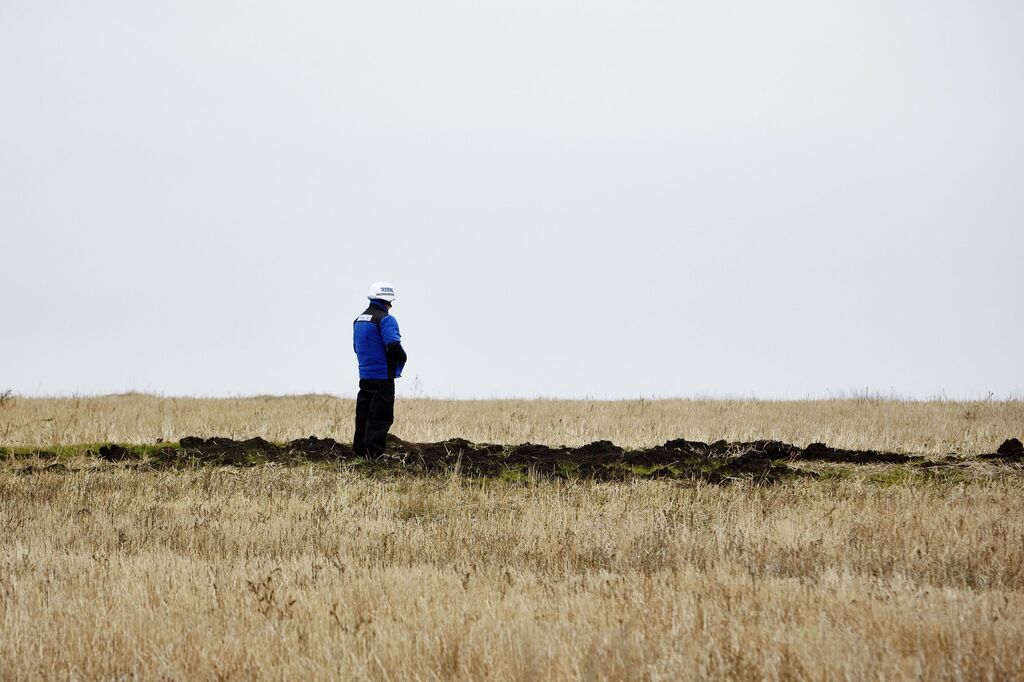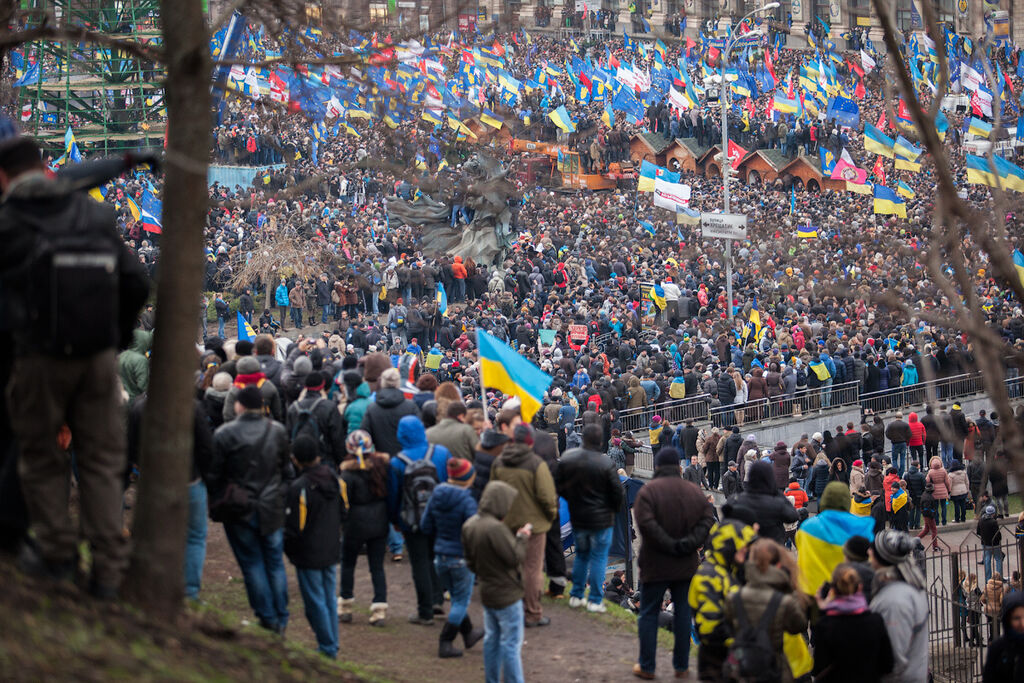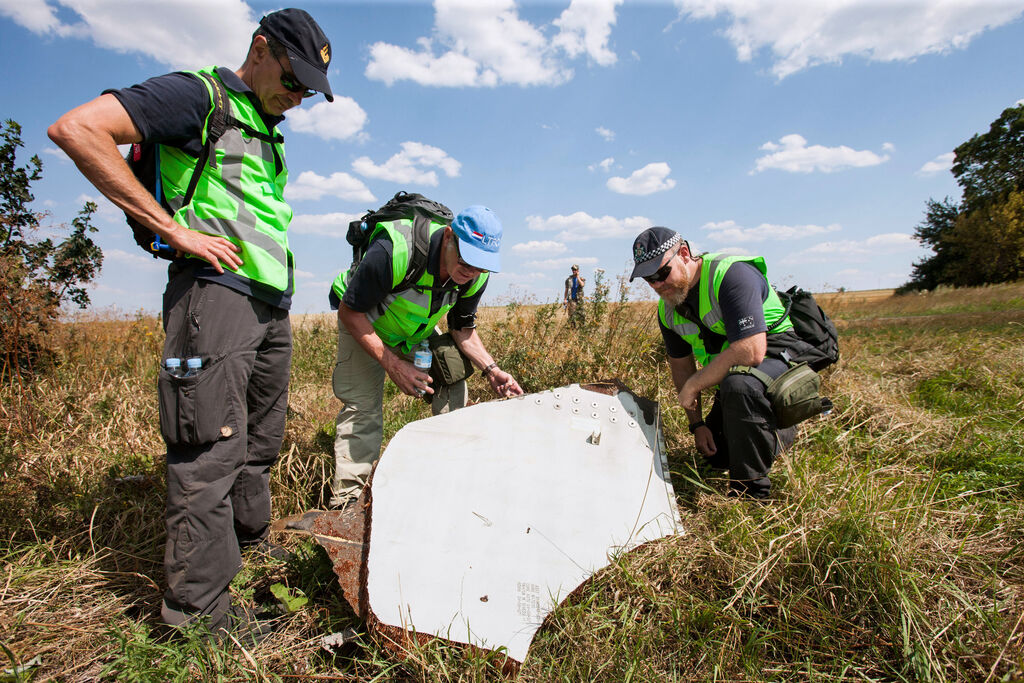Ten years after the downing of flight MH17, Kees Klompenhouwer, then Dutch ambassador in Kyiv, reflects on the crucial diplomatic choices the Netherlands made at the time. The quality of the Dutch diplomatic, operational and judicial approach increased the country's international authority. But this outcome was far from certain on the day of the attack: even the Netherlands, so hard-hit by the disaster, almost missed the deeper geopolitical signal emanating from this act of aggression.
Dit artikel is ook te lezen in het Nederlands.
 17 November 2014. An OSCE observer investigates the crash site in Grabovo, Ukraine. Photo: Pierre Crom | ANP
17 November 2014. An OSCE observer investigates the crash site in Grabovo, Ukraine. Photo: Pierre Crom | ANP
By Kees Klompenhouwer
My strongest memory of the MH17 disaster of 17 July 2014 is – apart from the painful shock of the images of so many (298) innocent victims in a Ukrainian field – the great solidarity of the Dutch people and its government services with the victims’ relatives in dealing with the crisis. This mutual solidarity was also put into practice in Kyiv, Kharkiv and in the area of operation.
Nevertheless, the geopolitical aspect would prove to be at least as important as national solidarity. MH17 was part of a larger crisis. It horrifically illustrated the true – criminal – face of Putin's armed aggression against Ukraine, which began in 2014. However, it would take 8 years, until the full-scale invasion of Ukraine by Russia in February 2022, for this fact to dawn on the West in full extent.
Within the Netherlands, MH17 was mostly about the mourning process for the bereaved families and the desire for justice to prevail over the crime, which the shooting of MH17 turned out to be. After a while, the outside world mainly saw the quality of the Dutch approach: diplomatically, operationally and judicially. The Dutch political leaders at the time, Prime Minister Mark Rutte and Minister of Foreign Affairs Frans Timmermans (Rutte II cabinet) gained visibility and authority on the international stage. This was new, because the previous Rutte I cabinet, with the support of Geert Wilders’s PVV, had seriously harmed the Netherlands’ international authority.
The plane had crashed in a war zone of which most Western Europeans barely realized it existed
On 17 July 2014, the day of the attack on a regular civil aviation flight, this outcome was by no means certain. What prevailed was confusion and – in Dutch public opinion – panic. The plane had crashed in the middle of a war zone that most Western Europeans had barely realized existed. NATO was only concerned with Afghanistan and did not have its eyes on the southeast of Ukraine. EU countries were still entangled with Putin's oligarchy with deep economic interests, and Ukraine was seen as of secondary importance. The interests of Russian oil and gas prevailed everywhere. Shortly after the annexation of Crimea, Mr Van Beurden, the CEO of our Royal Dutch Shell, had explicitly had a personal meeting with Putin to secure his investments in Russia (Sakhalin).
Missed signal
By concentrating on the aid and accountability dimensions after the MH17 disaster (how could this happen, who did it?), the Netherlands made the obvious choice from a humanitarian and domestic policy viewpoint, but even the hard-hit Dutch initially risked missing the deeper geopolitical signal that emanated from this act of aggression.
Dutch politics had already missed the signal of the Maidan, the massive manifestation of the will of the Ukrainian people to become a ‘normal’ European country: a country that focuses on the European model of civilization, of freedom and democratic accountability, and turns away from large-scale corruption of potentates and rejects the role of vassal in a straitjacket dominated by Russian imperialist ambitions. The discreet visit of Minister Timmermans in December 2013 to the Maidan and on the sidelines of an annual meeting of the OSCE in Kyiv was indeed an important sign of interest, but the only Dutch politician who had emphatically appeared on the stage of the Maidan to express his support, former foreign affairs spokesperson of the VVD and Member of the European Parliament, Hans van Baalen, was ridiculed in Dutch politics, especially by his own party (!).
On 9 November 2013, during a secret meeting at a Russian military airfield, Putin had pressured Ukrainian President Yanukovych to refrain from signing the long-awaited association agreement with the EU. After peaceful demonstrations by young people carrying European flags were bloodily suppressed at the end of November, a month-long popular uprising ensued in Kyiv's central square, the Maidan.
 Protests in Kyiv's central square, the Maidan, on December 2, 2013. Photo: Nessa Gnatoush via Wikimedia Commons.
Protests in Kyiv's central square, the Maidan, on December 2, 2013. Photo: Nessa Gnatoush via Wikimedia Commons.
After Putin, at the Sochi Olympics, had incited Yanukovych on 8 February to take tough action against the demonstrators, a massacre followed on the Maidan on Thursday 20 February, under the supervision of General Sergei Beseda of the Russian FSB, who was present in Kyiv, in which police snipers shot dead about sixty demonstrators. This happened while a block away, despite the audible shooting, Yanukovych continued to negotiate imperturbably with a troika of European ministers about a "peaceful solution". Yanukovych signed the agreement, but, well prepared, fled Kyiv the next day, eventually defecting to Russia via Kharkiv. On Saturday, February 22, the parliament deposed President Yanukovych by a large majority, including from his own party.
Putin used this scenario to a) deny the legitimacy of parliament and the government in Kyiv – he spoke of an ‘unconstitutional coup’ – and b) launch a well-prepared operation (Operation ‘Russian Spring’) to split off the east and southeast of the country, under the name ‘Novorossya’. On the same Saturday, February 22, Yanukovych was scheduled to address a congress in Kharkiv and announce the secession. Apparently, he didn't dare to do that. Russia took action anyway, with soldiers without insignia in Crimea and mercenaries in the Donbas.
The Dutch government, which felt stung by a wasp with MH17, did not seem to want to deal too deeply with the hornet's nest from which this nasty sting originated
All this seemed to arouse more surprise than indignation in Europe – and even ‘understanding’ in some countries. Putin's armed men were legitimized by the Western media with the term ‘separatists’. The Russian narrative that Ukraine was a ‘country divided to the bone’ was swallowed without much difficulty.
Even the Dutch government in The Hague, which felt stung by a wasp with MH17, did not seem to want to deal too deeply with the hornet's nest from which this nasty sting originated. It was now convinced of the usefulness of a few (limited) economic sanctions by the EU against Russia, but there could be no question of defence support to Ukraine against the aggression.
At the embassy, however, the hornet's nest was clearly visible.
The Russian threat
Armed ‘anti-Maidan’ demonstrations appeared to be popping up all over the country in March and April 2014. In addition, there are many reports that, in the East and South, the armed demonstrators were brought in from Russia by buses to occupy crucial government buildings. Subsequently, a classic Soviet revolutionary scenario with fake referenda and the establishment of ‘People's Republics’ was rolled out there.
In March, it was reliably reported that Russia had put an airmobile brigade on high alert on the other side of the border in Belgorod (48 hours). It would be able to occupy Kyiv airport in a short time. Our embassy then made plans for evacuation (by road) only as a precaution – and according to standard procedure. Nevertheless, it was decided to stay in the expectation that this occupation would not happen.
In April/May, with the help of the public, the Ukrainian security services managed to quell the Russia-ignited insurgencies against Kyiv in most cases, except in the cities of Donetsk and Luhansk. There, the Russians had taken control of the weapons stockpiles of Ukrainian police and security services at an early stage without much opposition. Ukrainian soldiers tried to push back the Russian infiltrators, who received support from Russia with artillery fire from the other side of the land border.
The shooting down of MH17 was a result of a decision by Moscow to further escalate the war and secretly provide the Russia-led irregular gang with powerful weapons, including armoured vehicles and high-range anti-aircraft missiles. The fact that this secret operation immediately endangered civil aviation became apparent only when it was too late. This carelessness illustrates the disregard for the lives of civilians that has become the hallmark of Russian actions under Putin.
Days of crucial diplomatic choices
At the start of the MH17 crisis on 17 July, it was unclear which country or agency should be in charge of providing aid and investigating the circumstances. However, the temporary chargé d'affaires at the embassy in Kyiv had immediately called in the OSCE monitoring mission present in the country to visit the disaster site. Its deputy chief monitor was already present at the crash site the next day to take stock and would play a crucial mediating role in the future.
The Malaysian government, owner of Malaysian Airlines, was the first to be considered for the lead of the salvage and investigation under civil aviation rules. Malaysia chose to cooperate with the de facto ruler on the site where the plane had crashed; Russia and its mercenaries. After my return to Kyiv on 18 July, I learned from a reliable source that, with Moscow's approval, Malaysian special forces had collected the black boxes and vital wreckage, which could clarify the circumstances, from the crash site. This led to great anger in Kyiv. Malaysia could not carry out the recovery and investigation into the disaster without Ukrainian cooperation.
Malaysia opted for cooperation with the de facto ruler on the site of the disaster: Russia and its mercenaries
The Prime Minister of Malaysia, Najib Razak, who had been confronted with a second major air disaster in just a few months, wanted to be relieved of that responsibility after a few days. He sent his foreign minister, Anifa Aman, to Kyiv for this purpose, where he asked to speak to me on the afternoon of July 21. On the way to his hotel, I received a phone call from the Ukrainian Deputy Minister of Foreign Affairs, Serhii Kyslytsia, who, to my surprise, was aware of my purpose of travel. Fortunately, I was able to accept Minister Aman's offer that the Netherlands would take the lead in the recovery mission and the investigation into the circumstances.
From the outset, the Dutch government had intuitively made the only right choice, namely, to seek cooperation with the legitimate authority, Ukraine, and to offer help. The OSCE was willing and able to negotiate with the Russian mercenaries on behalf of the Netherlands to gain access to the disaster area. Ukraine's State Service for Emergency Situations, DSNS, was still operational on the ground and was able to start collecting the victims.
On the morning of 21 July, the Ukrainian president decided on a temporary ceasefire to allow the recovery mission of the victims and informed Prime Minister Rutte that evening that he was prepared to put the Netherlands in charge of the recovery mission. Malaysia handed over the black boxes to the Netherlands on July 22 after signing the necessary papers, and later, after some games between intelligence services in Kyiv, a batch of collected wreckage. On 23 July, the first aircraft with body remains was able to land at Eindhoven Air Base after an emotional but subdued handover by the DSNS to the Dutch team in Kharkiv. It was a day of national mourning that many in the Netherlands remember. This was six days after the disaster. For the relatives, this was late, mainly because of the uncertainty in the first days about the fate of the dead at the crash site. However, given the exceptionally difficult circumstances, this first shipment was relatively fast, thanks to full Ukrainian cooperation. On 24, 25 and 26 July, further shipments to Eindhoven followed. The official and heavily equipped salvage mission from the Netherlands was able to start on 28 July.
Another key player was Australia, which had lost 27 nationals in MH17. Australia did not have an embassy in Kyiv at the time of the disaster. Prime Minister Abbott had immediately sent his former Chief of Defence Staff, decorated soldier and four-star General Allen ‘Angus’ Houston. He sought cooperation with the Netherlands, with which he had also worked together closely militarily in Afghanistan.
 Investigation at the MH17 crash site by a Dutch police officer, someone from the National Forensic Investigation Team and an Australian officer. August 3, 2014. Photo: Dutch Ministry of Defense.
Investigation at the MH17 crash site by a Dutch police officer, someone from the National Forensic Investigation Team and an Australian officer. August 3, 2014. Photo: Dutch Ministry of Defense.
There were major military and political risks associated with military intervention. On 24 July, at the suggestion of Minister Timmermans, in consultation with Ukraine, his Australian counterpart Julie Bishop and the head of the OSCE on the ground in Kyiv, a recovery mission of police and forensic experts was opted for, accompanied by the OSCE as negotiator on the spot. This was the model advocated by the Embassy. Within a few days, a draft treaty was put together by the lawyers of the Ministry of Foreign Affairs. The treaty (IMPI) gave us and Australia the necessary powers and immunities. It was signed in Kyiv on 28 July and ratified soon after. Then, also supported by the Ministry of Defence, the 300-strong police mission could be formally launched, with the Australian military joining in a new role. Pieter-Jaap Aalbersberg, chief of police of Amsterdam, was the head of mission. He reported directly to Prime Minister Rutte to avoid bureaucratic obstacles.
Increasing international standing
This dynamism contributed to the international authority of the Netherlands. Admittedly, this mission had to withdraw on 6 August for security reasons. It also turned out that many body remains had already been recovered. The work was continued on a smaller and more discreet scale to recover as much wreckage as possible and to allow for the criminal investigation. In general, it was possible to work in safety, although according to the Ukrainian services there was a bomb attack in Kharkiv in November 2014 near the location where the Netherlands had its operational headquarters. Meanwhile, Russia continued to spread disinformation about the cause of the disaster and the investigation, to which some parliamentarians in the Netherlands expressed sensitivity. Vigilance was still necessary.
His leading role in the MH17 crisis kicked off the upward trend in Prime Minister Rutte's international reputation
The Dutch commitment to top-quality forensic research made it possible to identify all but a few of the 298 victims – including the non-Dutch ones. The quality of the subsequent investigation into the circumstances by the Safety Board and subsequently into the criminal responsibility under the Dutch Public Prosecution Service also strengthened the Dutch international authority. It can be said that because of this – and because of his leading role in the MH17 crisis - the upward trend in Prime Minister Rutte's international reputation began.
However, due to the curious Dutch referendum on the association agreement with Ukraine a while later, initiated by a bunch of political vandals, the Dutch authority was in danger of being undermined. Faced with criticism from European and American leaders, Dutch diplomacy, led by Rutte, found a diplomatic and legal ‘goat trail’ that solved this problem. In concrete terms, this was an addendum to the association agreement, a legally binding declaration that this treaty did not rule on Ukraine's membership of the EU. After all, during the public debate on the referendum, concerns were expressed – wrongly – about the existence of a possible automatic EU membership in the association agreement. These concerns about the treaty were thus definitively allayed. In May 2017, the Netherlands was the last EU country to ratify the association agreement, for which many lives had already been sacrificed on the Maidan in Kyiv and in defending against the subsequent Russian aggression.
This narrowly prevented Russian aggression against Ukraine – and the killing of 196 Dutch citizens with the downing of MH17 – from being rewarded.
Kees Klompenhouwer was the Dutch ambassador to Ukraine from 2013 to 2017. He is also the former ambassador to the Federal Republic of Yugoslavia (1999-2002) and the Czech Republic (2017-2021).
Dit artikel is ook te lezen in het Nederlands.
